Introduction
The medical dictionary define ‘Colostrum’ as ‘the first milk secreted at the time of parturition, differing from the milk secreted later, by containing more lactalbumin and lactoprotein, and also being rich in antibodies that confer passive immunity to the newborn, also called “foremilk”. It lasts for 2- 4 days after the lactation is started. Colostrum is very important component of the breast milk and it has role to play in immune system of every mammal.
Human colostrum (HC) is the first milk produced after birth and is particularly rich in immunoglobulin (Ig), antimicrobial peptides (lactoferrin and lacto peroxidase) and other bioactive molecule, including growth factors which are important for nutrition, growth and development of newborn infants and also for passive immunity. Bovine colostrum (BC) is produced by the cows during the first several days post parturition. This “early” milk has nutrient profile and immunological composition substantially different from ‘mature’ milk. It contains macronutrient like proteins, carbohydrate, oligosaccharides, fats and micronutrients like vitamins and minerals, also growth factors, anti-microbial compounds and immune regulating constituents either not present in milk or present substantially in lower concentration.
Hence, both human and bovine colostrum a complete diet with all the essential nutrients for the neonate during the initial phase of its life, colostrum also provides essential immunological protection. In ruminants in particular, for which no exchange of immune factors occurs in utero, colostrum and, to a lesser extent, milk provide protection through a high immunoglobulin (Ig) content, without which the ruminant would not survive.
‘Colostrum is one of the natural sources of vital growth and healing factors’
Colostrum supports the human organism in two main ways. First, its multiple immune factors and natural antibiotics provide strong support for the immune system. Second, its many growth factors offer a broad- spectrum boost to the organism to encourage optimum health and healing. The immunoglobulin, growth factors, antibodies play a role in prevention of infection that is in passive immunity. The vital nutrients help for tissue development, growth and energy. The growth factors present in the colostrum provide a novel treatment option for gastrointestinal conditions. Human colostrum has higher concentration of growth factors as compared to bovine colostrum.1, 2 The tables and figure below indicate how HC and BC differ in their nutrient content, immunological factors and growth factors.(Figure 1, Table 1, Table 2, Table 3)
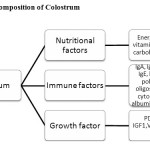 |
Figure 1: Composition of Colostrum Click here to View figure |
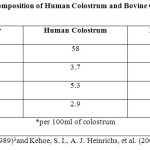 |
Table 1: Nutritional Composition of Human Colostrum and Bovine Colostrum Click here to View table |
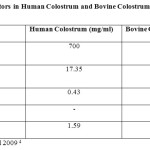 |
Table 2: Immune Factors in Human Colostrum and Bovine Colostrum Click here to View table |
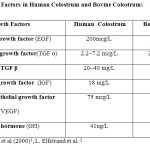 |
Table 3: Growth Factors in Human Colostrum and Bovine Colostrum Click here to View table |
‘Bovine Colostrum Is Universal Donor of Colostrum to Human’
Historically colostrum has been used for various illnesses in India as well as abroad for thousands of years.Ayurvedic physicians of India have used bovine colostrum for both medicinal and spiritual purposes since cows were first domesticated.
By the late 18th century, Western medicine started to take an interest in colostrum and study it for its potential health benefits. As a consequence, it was prescribed for many conditions, including immune system enhancement.5
Interestingly, until the development of penicillin and other artificial antibiotics in the 20th century, colostrum was commonly used for fighting bacterial infections. In the early 20th century it was noted that antibody levels in the first milk produced after birth were much higher than levels found in the milk that was produced 72 hours later.There are now over 2000 published scientific articles that document the safety and efficacy of using colostrum. This seemingly perfect food has been shown to be non-species specific.5 In 2005, it was reported that is safe and effective in repair of tissues as well as for enhancing immunity.6
Bovine colostrum (BC), which can be obtained in large quantities, has been found to be almost identical to human colostrum in terms of its beneficial components. It has also been found to be equally useful for many mammal species, and produces no side-effects. The use of bovine colostrum as dietary supplement has increased substantially over the past decades.Bovine colostrum is harvested within first few hours of calving from dairy animals. The herds of cows are kept under close supervision in good state of hygiene without exposure to antibodies, pesticides and anthelmintic. They are monitored according to FDA criteria. The colostrum collected within 24 hours contains maximum substances but less in amounts, colostrum collected later will be more but contain less immunoglobins.6 (Table 4)
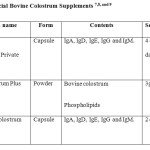 |
Table 4: Commercial Bovine Colostrum Supplements 7,8, and 9 Click here to View table |
Colostrum: An Ancient Food for Modern Times
Exercise Performance and Body Composition
Colostrum could be the most important natural substance to help athletes (from weekend warriors to professional athletes) achieves their desired results. Research shows that colostrum can help to increase strength and endurance, build lean muscle mass, burn body fat, boost immune function, which typically dips after strenuous exercise, shorten recovery time and accelerate healing of injuries.
Colostrum contains the growth factors that help build lean muscle, including insulin-like growth factors (IGF-I & IGF-II) and growth hormone (GH). IGF-I, which is found naturally in colostrum, is the only natural hormone capable of promoting muscle growth by itself. The IGFs in humans and cows are identical, but bovine colostrum actually contains a greater concentration of IGF-I than human colostrum. This fact makes bovine colostrum attractive to bodybuilders, athletes and others seeking to gain muscle mass. According to a study conducted in Finland, IGF-1 induces protein synthesis, which leads to an increase in lean muscle mass without a corresponding rise in adipose (fat) tissue. The growth factors in colostrum “shift fuel utilization from carbohydrate to fat. It mean that body will burn more fat, including fat made from the carbohydrate and protein that are consumed, producing fuel more efficiently. 10
IGF 1 found in colostrum is capable of promoting muscle growth by itself. IGF 1 is in higher amounts in bovine colostrum as compared to HC. According to study conducted in Finland, IGF 1 induces protein synthesis which leads to increase in lean body mass without a corresponding rise in adipose tissue.
The IGF-1 in colostrum increases uptake of blood glucose and facilitates the transport of glucose to the muscles, which keeps energy levels up. Together with growth hormones, IGF-1 also slows the rate of protein breakdown (catabolism) that occurs after a vigorous workout. It speeds up protein synthesis, which results in lean muscle mass without an increase in the amount of stored fat. Colostrum improves the assimilation of nutrients, which leads to improved energy levels andperformance. Also, the immune factors in colostrum help athletes to minimize their susceptibility to infections while being able to keep up with their training schedules.
As the IGF 1 in bovine colostrum, structurally identical to that found in human.6 Since IGF 1 has anabolic effect and is involved in the regulatory feedback of growth hormone. It is said that when athletes are in intense period of training, many athletes develops gut problem – runner trots.This is caused by combination of stress and by raising their body’s core temperature by about two degree, which seems to increase gut permeability. There istendency to leakiness increases 2- 3 fold during intense training like Olympics. But when bovine colostrum supplements were given for 2 weeks prior to exercise, it is seen that leakiness was completely prevented. This is because the colostrum contains growth factor that strengthens the gut lining.1
A randomized, double-blind, placebo- controlled trial on the effects of bovine colostrum on performance and body composition was conducted on 13 elite female rowers. Six subjects received 60g Bovine colostrum daily and seven subjects received a similar amount of whey protein concentrate as a placebo during nine weeks of pre-competition training. The distance covered and work performed during a four-minute maximal rowing effort was significantly greater in the group receiving bovine colostrum. These results suggest supplementation with BC improves certain aspects of rowing performance in elite female rowers.11
A study reported that eight weeks of colostrum supplementation resulted in an improvement in cycling performance. These findings were presented at the Pre-Olympic Sports Medicine Conference in Brisbane. Compared to their initial performance eight weeks earlier, the group taking 20 grams of colostrum per day completed the time trial 158 seconds faster whereas the group taking whey protein improved their performance time by only 37 seconds.12
A double-blind, randomized, placebo controlled study investigated the effect of eight weeks of supplementation with bovine colostrum on body composition and exercise performance in 17 female and 18 male elite field hockey players. Subjects received either 60g BCdaily or a whey protein concentrate as a placebo. While improvements in sprint performance occurred in both active and placebo groups, a significantly greater improvement was observed in subjects receiving bovine colostrum compared to placebo. No statistically significant improvement in vertical jump performance was observed as a result of bovine colostrum supplementation. No significant changes in body composition or measures of endurance were observed between the two groups.13
Another growth factor of colostrum, platelet-derived growth factor (PDGF) helps to stimulate the production of other growth factors, including IGF-1. Other growth factors in colostrum that help in the healing of injuries include growth hormone (GH) shown to accelerate bone regeneration, TGF α and TGF β shown to regulate cellular migration, proliferation and fibroblast growth factor (FGF) shown to be a powerful stimulator of angiogenesis and a regulator of cellular migration and proliferation. Cytokines also show great potentials in future clinical application, as they have been shown to accelerate tendon repair.14,15,16
A last minute illness is a real fear for athletes and colostrum seems to give immune system a boost that can reduce the risk.Supplementation of 60 grams of bovine colostrum daily containing 75% protein and 15% IgG improved athletic performance. And 20 grams of bovine colostrum, containing 80% protein said to improve body composition.17
Autoimmune Diseases/ Leaky Gut Syndrome
Colostrum contains immune factors which can regulate the immune response, growth factors to help to repair damaged cells and anti-inflammatory substances to reduce inflammation.(Figure 2)
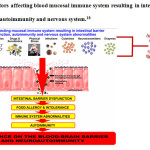 |
Figure 2: Factors affecting blood mucosal immune system resulting in intestinal barrier dysfunction, autoimmunity and nervous system.18 Click here to View figure |
Proline rich protein (PRP) fromcolostrum acts as regulatory substances of the thymus gland. It improves or eliminates symptomatology of both allergies autoimmune diseases. PRP inhibits overproduction of lymphocytes and T cells and reduces pain, swelling and infection.Lactoferrin from colostrum restores humoral immune response which is mediated by T cells and B cells.19 Lactoferrin minimizes the viral and bacterial infections and beneficial in maintaining gut permeability and stability. EGF helps to reverse the destruction of skin cells that can occur with autoimmune disorder. TNF stimulates tissue repair.
Several studies have shown that NSAIDS taken for 1-7 days increases gut permeability approximately threefold. But when colostrum was taken with the NSAIDS there was no increase in permeability.
Cancer
Lactoferrinhelps to prevent or shrink cancer cells.Lactoferrin prevents colon, bladder, tongue, esophagus, lung cancer. This is due to effect of lactoferrin as it boosts immunity. Colostrum contains milk fats which have anti carcinogenic properties. Conjugated linolenicacid (CLA) in colostrum has anti carcinogenic properties.
The mechanism of CLA’s anti carcinogenic properties is not clearly understood. There are few researches which prove this theory. In an in vitro study, CLA has been found to stimulate the production of lymphokines and interleukin 2, by 32% and 29% respectively and also increases certain levels of immunoglobins. It also said to lower immunosuppressive substances like leukotrienes and prostaglandins. 21 (Figure 3)
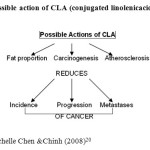 |
Figure 3: Possible action of CLA (conjugated linolenicacid) on cancer Click here to View figure |
CLA is said to inhibit carcinogens by inducing apoptosis through mechanism involving inhibition of eicosanoids synthesis. CLA decreases the amount of arachidonic which then decrease the eicosanoids and PGE2 synthesis. The eicosanoids receptors have been shown to control the release of messengers which are important for cell proliferation, differentiation and apoptosis.
Gastrointestinal Disorder
GI tract is barraged with lots of microbiological organism, antigens, food ingredients and drugs. These do have effect on the GI tract by the way of direct action or by stimulation of the immunological process. Colostrum has immunological factors that protect against micro organism. Colostrum contains trypsin inhibitors and unchanged colostrum goes down the GI tract maintain the healthy epithelium linings and immune system. This way colostrum protects against GI disorders.22 The hyper immune bovine colostrum raised against particular infection is very specific to tract and prevent the infection to host.23
Helicobacter Pylori infection:
H pylori require lipids to bind with gastric mucosa. Colostrum prevents the adhesion of this organism to the lipid binding sites of the GI tract. Studies have shown that bovine colostrum has potential to stop adhesion activity of H Pylori and H Mustelae. As colostrum prevents the adhesion of this microorganism therefore it can ever prevent peptic ulcers occurrence.24 A dose of 20grams of hyper immune bovine colostrum containing anti H pylori bovine Immunoglobulin was given to nine adults with gastritis for 3 – 4 weeks and it was seen that the severity of symptoms was reduced and inflammation and organism was eradicated is one subject.25 The severity of symptoms and rate of colonization were reduced in 20 children positive of H Pylori, when given 12g hyper immune bovine colostrum. But the organism was not eradicated.26 Breastfeeding protects against early acquisition of H Pylori. The concept of passive immunization is a logical alternative approach as it similar to natural means of protecting from infectious disease.
NSAIDS induced GI inflammation & permeability:
Non-steroidal anti-inflammatory drugs (NSAIDs) are most commonly prescribed medicine worldwide.Administration of NSAIDs causes gastric and intestinal damage like peptic ulceration and injury to small and large intestine. It causes increased permeability with protein and blood loss also stricture formation.27
Approximately 2% of subjects taking NSAIDs over a year suffer from adverse gut adverse effect including bleeding, perforation and inflammation. Acid suppressants and prostaglandin analogues have been shown to be effective in reducing gastric injury induced by NSAIDs but are less effective in preventing small intestinal injury. Therefore novel therapies are required for treatment.
Growth factors like α IGF 1, β IGF 1, transforming growth factor (TGF) and epidermal growth factors (EGF) are present in human and bovine colostrum. These growth factors are capable of stimulating gut growth and repair process of GI tract.1
A study was conducted to determine what effect dietary supplementation might have on NSAID induced GI inflammation and permeability (if any). Bovine Colostrum utilized in the two trials contained approximately 43 g/L protein content (primarily consisting of Immunoglobulin) and the following growth factor profile (values are approximations): IGF-I and II 2 mg/L, TGF-β 25 g/L, and EGF 6 g/L. The preliminary results obtained suggest benefits for persons acutely exposed to NSAIDs; however, BC did not appear to provide any GI benefits among persons chronically utilizing NSAIDs.17
A study with seven males, following an initial baseline permeability assessment, supplemented their diets with 125 mL BC or whey placebo three times daily for seven days. Indomethacin was introduced on days 3-7. After completing this arm of the trial, a two-week wash- out period was followed by a second arm of the trial in which participants receiving the active intervention were switched to the placebo, while those receiving the placebo received active treatment. Permeability increased approximately three- fold in response to indomethacin in the participants taking the whey placebo while no significant increase in intestinal permeability was observed when the BC preparation was co administered with indomethacin.1
In other study 15 persons taking NSAIDs (ibuprofen, piroxicam, voltarol, or naproxen) for at least one year were randomized to receive either 125 mL bovine colostrum or placebo three times daily for seven days with a two-week washout period between study arms. Baseline permeability assessments were lower in these persons than in volunteers in the previous trial (who were not taking NSAIDs chronically). No significant effect of either the active or placebo treatment was observed.1
Currently there are few studies that support this observation as the clinical trial are still been carried out in patients with long term use of NSAIDs. In short-term doses of NSAIDs appear to consistently increase intestinal permeability; it is possible that long-term use of NSAIDs results in an adaptation response by the small intestine, at least in certain individuals. Irrespective of the explanation, bovine colostrum appear to hold promise as a dietary addition in persons be- ginning NSAIDs, but not for persons chronically taking NSAIDs while being free of adverse GI effects. A daily dose of 15 grams of bovine colostrum may be beneficial in NSAIDs induced gut dysfunction.
It was seen that 15 grams of bovine colostrum containing protein content of approximately 43%, helps to prevent NSAIDS induced GI dysfunction.17
Immunodeficiency related Diarrhea and Infective Diarrhea:
Diarrhea caused by Cryptosporidium parvum is common among persons with immunodeficiency syndrome. There various other bacteria and parasites that cause serve diarrhea in patients with advanced human immunodeficiency virus infection. But there are conflicting evidence suggesting that BlastocystisHomins, CamplyobacterJejuni and Giardia Lamblia should be included among the infectious agents capable of causing HIV related diarrhea.
A combination of case reports and clinical trials suggest bovine colostrum might be beneficial in treatment of chronic diarrhea among patients with immune deficiency syndrome.
Twenty-nine AIDS patients were treated for 10 days with 10 g per day of a BC product concentrated for Immunoglobulin. The average daily stool frequency decreased from 7.4 to 2.2 by the end of the 10-day treatment period. Four patients were considered non-responders and did not benefit from the intervention. After discontinuation of the dietary supplement, 12 patients re-experienced diarrhea, while 14 remained free from diarrhea for at least four weeks. Cryptosporidia had been found in the stools of four persons in the trial prior to the intervention. After the 10-day intervention, levels of this microbe were undetectable.28
Eighty-seven adult patients with HIV-associated diarrhea were recruited at Gulu Hospital and four community clinics in Northern Uganda. Forty-five patients were randomized to receive 50 g of colostrum-based supplement twice a day for 4 weeks in addition to standard anti-diarrhea treatment, and 42 patients received standard anti-diarrhea treatment alone. Patients were followed up for 9 weeks. Daily stool frequency was recorded, and body weight and body mass index were evaluated at weeks 1, 4 and 9. Baseline CD4 + count were measured at baseline and at week 9. It was seen that Mean daily stool frequency decreased by 79% from 7.5 to 1.3 motions over the study period in patients on colostrum-based supplement, compared to a 58% reduction in controls. Self-reported fatigue was reduced by 85% in patients on colostrum-based supplement by week 9 compared to 43% reduction amongst controls. Patients on colostrum-based supplement had 11% increases in mean body weight and body mass index by week 9, but no changes were observed in control subjects. Mean CD4+ count increased by 14% for patients on colostrum-based supplement, in contrast to 12% decrease in controls.29
A similar study carried out at Braithwaite Memorial Specialist Hospital, Port Harcourt, Nigeria. Thirty patients with HIV- associated diarrhea were included in the study. The patients were treated with ColoPlus for 4 weeks in an open labeled non-randomized study, after an observational period of one week. After a post-treatment period of another two weeks, treatment with anti-HIV drugs was started, if deemed appropriate. It was seen that there was a dramatic decrease in stool evacuations per day a substantial decrease in self-estimated fatigue of 81%, an increase in body-weight of 7.3 kg per patient and an increase in CD4+ count by 125%.29
A case of 38 year old homosexual man with HIV and Cryptosporidium parasite excreted 6 to 12 liters of stool every day for at least 3 months. Trial with more than six antidiarrheal medications was ineffective. The patient was given dose of hyperimmune bovine colostrum by direct duodenal infusion. During infusion patients fecal output decreased to less than 2 liters per day after 48 hours of treatment. The stools were formed and Cryptosporidium parasite was absent. The person remained asymptomatic for 3 months. Therefore it can be said that bovine colostrum is novel therapy.30 It was seen that 10 grams of bovine colostrum proved to be beneficial in preventing immunodeficiency related diarrhea and also infectious diarrhea.17
Wlodzimierz Otto et al (2011) study evaluated the efficacy of tablets on 30 participants, containing 400 mg of colostrum protein, taken thrice daily with bicarbonate buffer. This regimen conferred 90.9% protection against diarrhea in the group receiving the active preparation compared with the placebo group. The second study examined the efficacyof tablets containing 400 mg colostrum protein given with buffer 83.3% protection; or without buffer 76.7%protection. And tablets containing 200mg colostrum protein given without buffer (58.3% protection, compared with placebo. The difference between buffered and unbuffered treatments was not significant.31
Colostrum also plays a role in rotavirus and Salmonella Typhi infection protection as well as antibiotic related diarrhea due to presence of lactoferrin. Studies have shown that hyper immune bovine colostrum, derived from cows immunized with rotavirus, can prevent rotavirus diarrhea when given passively. Hyper immune colostrum containing different levels of rotavirus antibody was administered to 105 children attending nine Adelaide childcare centers. Subjects were asked to drink 100 ml of whole milk supplemented with colostrum 3 times a day, for a period of 6 days. Stool samples were collected from the subjects before, during and after consumption of the study product. Rotavirus antibody activity was detected in 521 (86%) of 602 fecal specimens obtained during the study using the virus reduction ELISA. The antibody activity was detected as early as 8 hours after ingestion of hyper immune colostrum and up to 72 hours after consumption had ceased. There was a strong relation between the titer of rotavirus antibody administered to subjects and the level of antibody activity detected in the feces.The results show that antirotavirus activity survived passage through the gut. Therefore, passive immunotherapy may be used to prevent or treat infectious diseases that affect the entire length of the gastrointestinal tract.32
Eighteen adults 20-25 years with Salmonella Typhi infections were given 100ml/prepacked bovine colostrum and group 2 were given false colostrum. It was seen that bovine colostrum neutralizes the infective agent and toxins. Its effect was seen when colostrum immunoglobins modified the interaction of adhesion of pathogens to their target tissues. Thereafter, decreasing the effect of pathogens on the gastrointestinal tract.33 It was seen that colostrum has lethal effect on E Histolytica and it protects against diarrhea.34
Administration at the start of antibiotic treatment reduces the attack rate of diarrhea becausecolostrum contains lactoferrin which has antimicrobial and anti-inflammatory effect.35
Conclusion
The nutritional composition of colostrum favors its use as Ancient Food for Modern Times and hence can be considered as a nutraceutical. Colostrum as reviewed can be of use in variety of setting –athletic performance, maintenance of integrity of mucosa, permeability, local immunity, systemic immunity and antigen handling. Colostrum supplements can play an important role in autoimmune disorders like rheumatoid arthritis. As immune modulator as well as have scope in maintenances of growth in children due to presence of growth factors.
References
- Raymond J Playford, Christopher E Macdonald and Wendy S Johnson. Colostrum and milk-derived peptide growth factors for the treatment of gastrointestinal disorders. Am J ClinNutr; 72:5–14 (2000).
- AFO.Kaducu, S.A.Okia, G.Upenytho, L.Elfstrand and C.-H. Florén. Effect of bovine colostrum-based food supplement in the treatment of HIV-associated diarrhea in Northern Uganda: a randomized controlled trial. Indian J Gastroenterology 30(6):270–276 (2011).
CrossRef - Guthrie AH. Introductory Nutrition. St. Louis, MO: Times Mirror/Mosby College Publishing (1989).
- K. Stelwagen, E. Carpenter, B. Haigh, A. Hodgkinson and T. T. Wheeler. Immune components of bovine colostrum and milk. Journal of animal science; 87- 13 (2009).
- http://www.vitabase.com
- B R Thapa Health factors in colostrum. Indian journal of pediatrics: 72 (2005).
CrossRef - Indian B-Colostrum– Biostrum Nutritech Pvt.Ltd. http://www.bcolostrum.com/indianbcolostrum.htm
- Symbiotics, Colostrum Plus, Powder. http://www.iherb.com/Symbiotics-Colostrum-Plus-Powder
- Zenith Nutrition. http://www.zenithnutrition.com
- Schwade, S. Insulin-like growth factors. Muscle &Fitness. (1992).
- Hofman Z, Smeets R, Verlaan G, et al. The effect of bovine colostrum supplementation on exercise performance in elite field hockey players. Int J Sport NutrExercMetab 2002;12:461-469.
CrossRef - Gregory S. Kelly, ND. Bovine Colostrum’s: A Review of Clinical Uses. Alternative Medicine review; 8(4):378-394 (2003).
- http://laurenbeatssugar.blogspot.in
- JolantaArtym, Michal Zimecki and Marian L. Kruzel. Effect OfLactoferrin On the methotrexate-induced suppression of the cellular and humoral immune response in mice. Anticancer research; 24: 3831-3836 (2004).
- Michelle Chen &Chinh Huynh. Weapons of targeted destruction. http://www.odec.ca/projects/2008/huyn8c2/CLA.html.
- Macdonald, Helen B. Conjugated linoleic acid and disease prevention: A review of current knowledge. Journal of American college of nutrition; 10(2):111s-118s (2000).
- Antonius C. M. Van Hooijdonk, K. D. Kussendrager and J. M. Steijns. In vivo antimicrobial and antiviral activity of components in bovine milk and colostrum involved in non-specific defense. British Journal of Nutrition, (2000).
- PawanRawal, Vineet Gupta and B.R. Thapa. Role of Colostrum in Gastrointestinal Infection. Indian Journal of Pediatrics ; 75 (9) : 917-921(2008).
CrossRef - A K Bogested et al. H Pylori infection IGA deficient lack of role of secretory immune system. Clinical and experimental immunology journal ; (2000).
- Mitra A K, Mahatanabis D, Ashraf H et al. Hyperimmune cow colostrum’s reduces diarrhea due to rotavirus: a double- blind, controlled clinical trial.Acta paediatrica;84: 996-1001 (1995).
CrossRef - Oona M, Rigo T, Maaroos H, et al. Helicobacter pylori in children with abdominal complaints: has immune colostrum some influence on gastritis? AlpeAdria Microbiology Journal; 6:49-57(1997).
- F. O. Kaducu, S, A. Okia G, Upenytho, L. Elfstrand and C.-H. Florén. Effect of bovine colostrum-based food supplement in the treatment of HIV-associated diarrhea in Northern Uganda: a randomized controlled trial. Indian J Gastroenterol ; 30(6):270–276 (2011).
CrossRef - Claes-Henrik Flore ´N, Sonny Chinenye, Lidia Elfstrand, ConnyHagman and IngemarIhse. ColoPlus, a new product based on bovine colostrum, alleviates HIV-associated diarrhea. Scandinavian Journal of Gastroenterology; 41: 682 – 686 (2006).
CrossRef - W Otto et al.Randomized control trial using a tablet formulation of hyperimmune bovine colostrum to prevent diarrhea caused by enterotoxigenic E Coli in volunteers. Journal OF Gastroenterology(2011).
- Brinkworth GD, Buckley JD, Bourdon PC, et al. Oral bovine colostrum supplementation enhances buffer capacity but not rowing performance in elite female rowers. Int J Sport Nutrition Exercise Metabolism;12:349-365 (2002).
CrossRef - Coombs JS, et al. Dose effects of oral bovine colostrum on physical work capacity in cyclists. Medicine Science Sports Exercise 34(7): 1184-8 (2002).
CrossRef
- Molloy T, et al. The roles of growth factors in tendon and ligament healing. Sports Medicine; 33(5):381-94 (2003).
CrossRef - Schmidmaier G, et al. Improvement of fracture healing by systemic administration of growth hormone and local application of insulin-like growth factor-1 and transforming growth factor-beta1 Bone:\; 31(1):165-72 (2002).
- Liang L, et al. Effect of cytokines on repair of tendon injury. ZhongguoXiu Fu Chong JienWaiKeZaZhi (Chinese); 14(5):283-5 (2000).
- Allision MC Allan, Howaston AG et al. Gastrointestinal damage associated with the use of NSAIDs. N England Journal of Medicine; 327 – 749 (1992).
- Stephan W, Dichtelmuller H and Lissner R. Antibodies from colostrum in oral immuno- therapy. J ClinChemClinBiochem; 28:19-23 (1990).
- JaninaPacyna, KasiaSiwek, Sandra J. Terry, Elizabeth S. Roberton, Ronald B. Johnson, and Geoffrey P Davidson. Survival of rotavirus antibody activity derived from bovine colostrum after passage through the human gastrointestinal tract. Journal of Pediatric Gastroenterology and Nutrition; 32:162–167 (2005).
- Fang He, ElinaTuomola, HeikkiArvilommi and SeppoSalminen. Modulation of human humoral immune response through orally administered bovine colostrum.FEMS Immunology and Medical Microbiology, 31: 93 – 96 (2001).
CrossRef - JaninaPacyna, KasiaSiwek, Sandra J. Terry, Elizabeth S. Roberton, Ronald B. Johnson, and Geoffrey P (2005). Davidson. Survival of rotavirus antibody activity derived from bovine colostrum after passage through the human gastrointestinal tract. Journal of Pediatric Gastroenterology and Nutrition; 32:162–167.
- Laffan AM et al (2011). Lactoferrin for the prevention of post antibiotics diarrhea. Journal of health population nutrition. December.
- Kehoe, S. I, A. J. Heinrichs, et al. (2007). A Survey of Bovine Colostrum Compositionand Colostrum Management Practices on Pennsylvania Dairy Farms. Journal of dairy science; 90: 4108-4116.
CrossRef

This work is licensed under a Creative Commons Attribution 4.0 International License.




